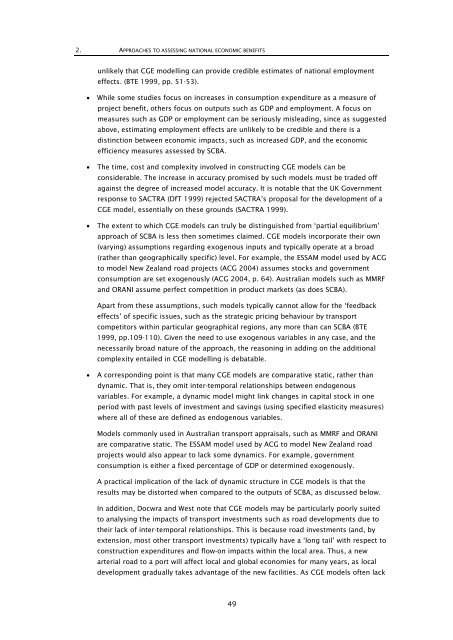Research 350 - NZ Transport Agency
Research 350 - NZ Transport Agency
Research 350 - NZ Transport Agency
You also want an ePaper? Increase the reach of your titles
YUMPU automatically turns print PDFs into web optimized ePapers that Google loves.
2. APPROACHES TO ASSESSING NATIONAL ECONOMIC BENEFITS<br />
unlikely that CGE modelling can provide credible estimates of national employment<br />
effects. (BTE 1999, pp. 51-53).<br />
• While some studies focus on increases in consumption expenditure as a measure of<br />
project benefit, others focus on outputs such as GDP and employment. A focus on<br />
measures such as GDP or employment can be seriously misleading, since as suggested<br />
above, estimating employment effects are unlikely to be credible and there is a<br />
distinction between economic impacts, such as increased GDP, and the economic<br />
efficiency measures assessed by SCBA.<br />
• The time, cost and complexity involved in constructing CGE models can be<br />
considerable. The increase in accuracy promised by such models must be traded off<br />
against the degree of increased model accuracy. It is notable that the UK Government<br />
response to SACTRA (DfT 1999) rejected SACTRA’s proposal for the development of a<br />
CGE model, essentially on these grounds (SACTRA 1999).<br />
• The extent to which CGE models can truly be distinguished from ‘partial equilibrium’<br />
approach of SCBA is less then sometimes claimed. CGE models incorporate their own<br />
(varying) assumptions regarding exogenous inputs and typically operate at a broad<br />
(rather than geographically specific) level. For example, the ESSAM model used by ACG<br />
to model New Zealand road projects (ACG 2004) assumes stocks and government<br />
consumption are set exogenously (ACG 2004, p. 64). Australian models such as MMRF<br />
and ORANI assume perfect competition in product markets (as does SCBA).<br />
Apart from these assumptions, such models typically cannot allow for the ‘feedback<br />
effects’ of specific issues, such as the strategic pricing behaviour by transport<br />
competitors within particular geographical regions, any more than can SCBA (BTE<br />
1999, pp.109-110). Given the need to use exogenous variables in any case, and the<br />
necessarily broad nature of the approach, the reasoning in adding on the additional<br />
complexity entailed in CGE modelling is debatable.<br />
• A corresponding point is that many CGE models are comparative static, rather than<br />
dynamic. That is, they omit inter-temporal relationships between endogenous<br />
variables. For example, a dynamic model might link changes in capital stock in one<br />
period with past levels of investment and savings (using specified elasticity measures)<br />
where all of these are defined as endogenous variables.<br />
Models commonly used in Australian transport appraisals, such as MMRF and ORANI<br />
are comparative static. The ESSAM model used by ACG to model New Zealand road<br />
projects would also appear to lack some dynamics. For example, government<br />
consumption is either a fixed percentage of GDP or determined exogenously.<br />
A practical implication of the lack of dynamic structure in CGE models is that the<br />
results may be distorted when compared to the outputs of SCBA, as discussed below.<br />
In addition, Docwra and West note that CGE models may be particularly poorly suited<br />
to analysing the impacts of transport investments such as road developments due to<br />
their lack of inter-temporal relationships. This is because road investments (and, by<br />
extension, most other transport investments) typically have a ‘long tail’ with respect to<br />
construction expenditures and flow-on impacts within the local area. Thus, a new<br />
arterial road to a port will affect local and global economies for many years, as local<br />
development gradually takes advantage of the new facilities. As CGE models often lack<br />
49
















